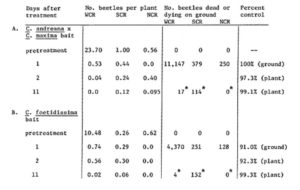Cucurbit Genetics Cooperative Report 6:79-81 (article 40) 1983
R. L. Metcalf, J. E. Ferguson, Dan Fischer, Richard Lampman and John Andersen
Departments of Entomology and Horticulture, University of Illinois, Urbana-Champaign, Illinois 61801
Wild species of Cucurbitaceae are well known for producing the intensely bitter oxygenated tetracyclic triterpenoids, the cucurbitacins (Cucs). These Cucs are kairomones for the herbivorous beetles of the tribe Luperini (Chrysomelidae, sub family Gallerucinae) that includes some of the most destructive insects of cucurbits and corn. The Cuc kairomones act as arrestants and compulsive feeding stimulants for the Diabroticina beetles of the new world and the Aulacophorina beetles of the old world and the beetles can readily detect them in nanogram quantities (1, 3).
This laboratory has been investigating the use of bitter Cucurbita baits containing very small amounts of carbamate, organophosphate, or pyrethroid insecticides for monitoring Diabroticina beetle populations or for mass destruction IPM programs (2, 4, 5). From studies over three summer seasons it appears that dried, ground Cucurbita fruits or roots containing Cuc contents of 0.1–0.3% are especially suitable ingredients for poisoned baits. Three plant sources of Cucs have been studied: a) C. andreana x C. maxima fruit averaging 5.0 mg Cucs B and D/g dry wt., b) C. texana x C. pepo containing equal amounts of Cucs E and E-glycoside at 6.1 mg/g (F1 fruit) or 3.0 mg/g (F2 fruit), and c) C. foetidissima roots with 4.0 mg Cucs E and I/g. Under field conditions, all three of these baits were effective in promoting arrest and compulsive feeding of the corn rootworms (D. virgifera LeConte WCR, D. undecimpunctata howardi Barber SCR, and D. longicornis Say NCR) and the striped cucumber beetle (Acalymma vittata Fab.). In laboratory tests, the baits were also effective against the banded cucumber beetle (D. balteata LeConte) and the western spotted cucumber beetle (D. u. undecimpunctata Mann.).
These air dried and ground Cucurbit baits were impregnated with a variety of insecticides including the carbamates – carbaryl, carbofuran, bendiocarb and methomyl; the organophosphates – trichlorfon, malathion, dimethoate, terbufos, and isofenphos and the pyrethroids – fenvalerate, permethrin, cypermethrin, decamethrin, and Pay-OffR. From laboratory and field studies it was concluded that the most effective toxicants for use with the ground baits were: methomyl, carbofuran, terbufos, and isofenphos at 0.1% and decamethrin at 0.01% w/w. These baits were broadcast at rates of 10 to 100 lb/A in cucurbit, sweet corn, and dent corn plots with high populations of Diabroticina beetles (1–25 beetles per plant). Evaluations of the effectiveness of the baits were made by a) comparing pre- and post- treatment counts of live beetles on the plants, b) counting dead or moribund beetles on the ground after the treatment, and c) measuring beetle catches on “sticky traps” baited with the sex pheromones of the southern and western corn rootworms. The results demonstrated that these poison bait applications at 10 to 30 lb. per A. produced reductions of adult Diabroticina beetles of 75–99+% within 1 to 3 days. The methomyl and isofenphos baits were effective at rates of 4.5 to 13.5g active ingredient per A and the decamethrin bait at application rates as low as 0.45 g per A. These substantial reductions in beetle populations resulted from insecticide application rates of about 1% those used in conventional spray applications, i.e. 1–2 lb. per A.
The following experiment on late sweet corn plots of 0.05A containing about 500 plants, treated by broadcast of 0.1% methomyl baits at 30 lb. per A (13.5g of methomyl per A) demonstrates the effectiveness of the bait applications.
Figure 1. Percent Control by days after treatment
*dying (moribund) beetles observed on ground in both plots for the 11 days after treatment indicating lengthy persistence.
From the experiments performed over the past three years, we conclude that dry poison baits formulated from ground bitter Cucurbita spp. or cultivars provide a superior technique for controlling adult cucumber beetles and corn rootworm beetles attacking cucurbits and corn. The use of the baits can provide adequate protection of these crops from adult beetle attacks at minimal dosages of insecticide and with minimal damage to populations of beneficial insects. This use of baits is therefore especially suitable for IPM programs. More research is needed to determine how the use of bitter cucurbit baits for adult corn rootworms might fit into long-term control programs for corn rootworms attacking field corn.
The research described was supported in part by a grant from the USDA, SEA Competitive Research Grants office 81-CRCR-1-0659. Any opinions findings and conclusions are those of the authors and do not necessarily reflect the views of USDA. Additional support was provided through a research grant from the American Cyanamid Co. We thank C. W. Bemis, Arizona State University for supplying the ground C. foetidissima root.
Literature Cited
- Metcalf, R. L., R. A. Metcalf and A. M. Rhodes. 1980. Proc. Nat. Acad. Sci. USA 77:3769–3772.
- Metcalf, R. L., A. M. Rhodes and E. R. Metcalf 1981. Cucurbit Genet. Coop. Rpt. 4:37–38.
- Metcalf, R. L., A. M. Rhodes, R. A. Metcalf, J. Ferguson, E. R. Metcalf and Po-Yung Lu. 1982. Environ. Entomol. 11:921–937.
- Rhodes, A. M., R. L. Metcalf and E. R. Metcalf. 1980. Cucurbit Genet. Coop. Rpt. 3:44–45.
